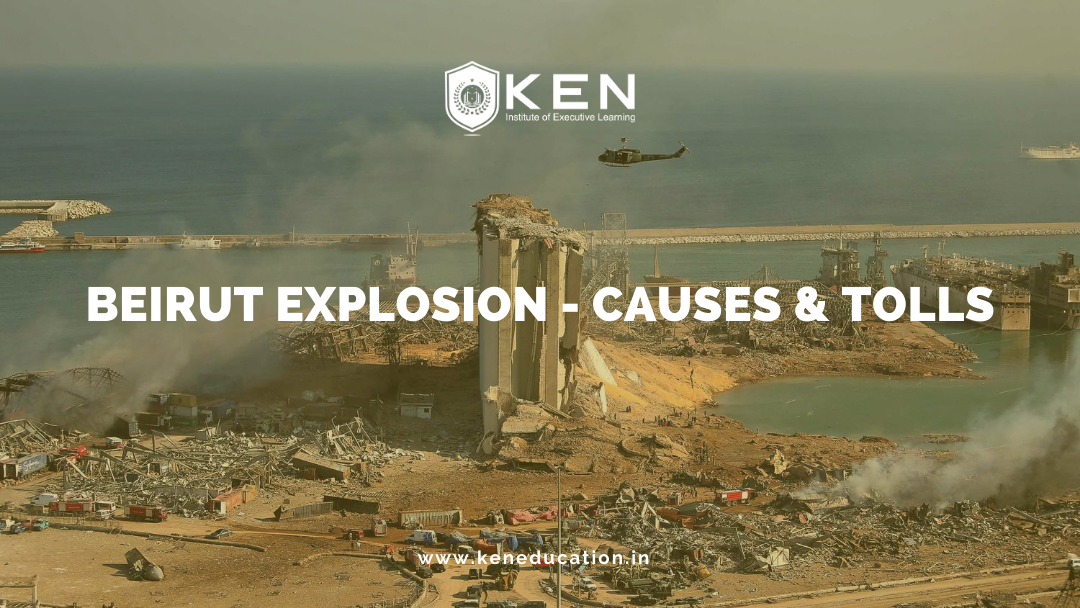The Massive Blast in the early morning of 4th August 2020, rocks Beirut, the Capital city of Lebanon. An initial large explosion in the port area of Beirut took place around 6:00 pm local time (15:00 GMT) resulting in a fire, multiple small blasts and then a profound explosion that levelled the harbour front and surrounding buildings. Beirut Explosion erupted next to a tall building called the Beirut Port Silos, which could be seen partially collapsed amid the rubble of nearby buildings including grain silos storing around 85% of the country’s grain was destroyed, imagery from the aftermath concluded. The part of Beirut half a mile around the port is completely flattened.
Seismologists measured the massive blast, which blew out windows at the city’s international airport nine kilometres (more than five miles) away, as the equivalent of a magnitude 3.3 earthquake. The blast killed at least 150 people and injured more
than 5,000 others. The whole city was shaken by the explosion and a thick mushroom cloud of grey smoke could be seen hanging around the Mediterranean before an enormous burst of red and orange fumes exploded into the sky.
The pictures and videos of people trapped beneath rubble wrecked cars and blast-damaged buildings were overwhelming in Beirut Explosion. Hospitals were already occupied fully with Covid-19 victims. The head of Lebanon’s Red Cross, George Kettani, described it as a “Huge Catastrophe” & added, “There are victims and casualties everywhere”.
What triggered The Massive Blast?
The Beirut explosion was caused by 2,750 tonnes of ammonium nitrate stored unsafely in a warehouse. The detonation of the material- used in bombs and fertilisers – sent shockwaves through the Lebanese capital, killing scores of people, injuring thousands, and leaving much of the city a mangled mess.
Officials said that an investigation was underway to find the exact trigger which caused the ammonium nitrate – which had reportedly been stored in a warehouse after it was unloaded from a ship impounded at the port in 2013 – to explode.
Ammonium Nitrate
It is a common industrial chemical used mainly as fertiliser in agriculture.
Ammonium nitrate is an odourless crystalline substance that has been the cause of numerous industrial explosions over the years. When combined with fuel oils, it turns into an ergastic explosive widely used in the construction industry, but also by
armed groups for contemporary explosive devices. It does not explode on its own and ignites only under the right circumstances. On explosion, it can release toxic gases including nitrogen oxides and ammonia gas.
Strict rules on how to store it safely: the site has to be fire-proofed, and not have any drains, pipes or other channels in which ammonium nitrate could build up.
Ammonium nitrate could only be turned into an explosive substance under certain circumstances when contaminated with items such as fuel oil it could cause an explosion.
How did this happen?
Letters show officials knew of the danger posed by ammonium nitrate cargo at Beirut port six years before the deadly blast. Analysis of public records and documents published online show senior Lebanese officials knew for more than six years that the ammonium nitrate was stored in Hangar 12 of Beirut’s port. And they were well aware of the dangers it posed.
So how did this happen? Was it deliberate?
There has been no indication from Lebanese officials that the explosions were caused deliberately. Here’s what the conclusions so far.
The cargo of ammonium nitrate arrived in Lebanon in September 2013, onboard a Russian-owned cargo vessel flying a Moldovan Flag. The Rhesus, according to information from the ship-tracking site, Fleetmon, was heading from Georgia to Mozambique.
According to lawyers representing the boat’s crew, “It was forced to dock in Beirut after facing technical problems at sea but Lebanese officials prevented the vessel from sailing, and eventually, it was abandoned by its owners and crew.
The ship’s dangerous cargo was then offloaded and placed in Hangar 12 of Beirut port, a large grey structure facing the country’s main north-south highway at the main entrance to the capital. Months later, on June 27, 2014, then-director of
Lebanese Customs Shafik Merhi sent a letter addressed to an unnamed “Urgent Matters judge” asking for a solution to the cargo, according to documents shared online.
One letter sent in 2016 noted there had been “no reply” from judges to previous requests. It pleaded “Given the danger of keeping these goods in the hangar in unsuitable climatic conditions, we reaffirm our request to please request
the marine agency to re-export these goods immediately to preserve the safety of the port and those working in it, or to look into agreeing to sell this amount” to the Lebanese Explosives Company.
Again, there was no reply. Nearly three years later, the ammonium nitrate was still in the hangar.
In Beirut, the massive explosion’s devastating aftermath:
Many Lebanese are expressing immense shock and sadness at the destruction, and great anger towards those who allowed this to happen. As many as 300,000 people became homeless. The explosion comes at a sensitive time for Lebanon. With Covid-19 infections on the rise, hospitals were already struggling to cope. Now, they are faced with attending thousands of injured people. Lebanon’s health sector was short of beds and lacked the equipment necessary to treat the injured and care for patients in critical condition.
The cause of the explosion is still not clear, but many Lebanese believe it to be the root cause; immense mismanagement in a broken state run by a corrupt political class who they say treats the country’s inhabitants with contempt.
“Join Ken Institute for comprehensive Health and Safety courses led by expert faculty, ensuring your readiness to tackle workplace fire emergencies effectively.”
In continuation to action
join us for more details at info@keninstitute.com
or visit our website www.keneducation.in or
call on +917569034271
Let’s connect on Facebook, YouTube, Linkedin, and Instagram.


